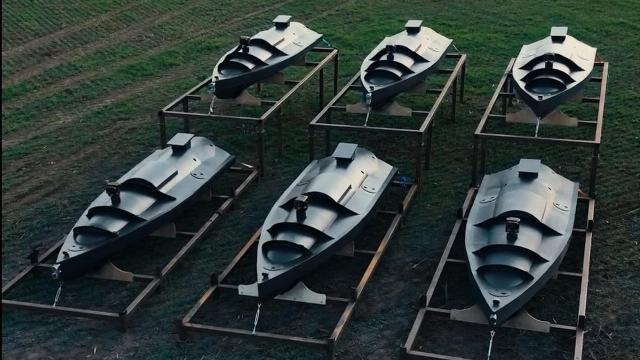At least since the end of 2022, Ukraine's ingenuity and necessity have led it to experiment with marine uninhabited vehicles (MNA) or what is commonly called "marine drones". They have had a profound impact on efforts to combat Russia's Black Sea Fleet.

By Giangiuseppe PILI
The article entitled "Marine drones at war: tactical, operational and strategic analysis of marine unmanned systems" (Sea drones at war: Tactical, operational and strategic analysis of maritime uncrewed systems) was published in the journal European Security & Defense. The author is Dr. Giangiuseppe Pili, associate professor of the Intelligence Analysis Program at James Madison University, a researcher at the NATO Defense College and the Proliferation and Nuclear Policy Research Group at RUSI. The style and vocabulary of the author are preserved.
The materials of the article contain exclusively the author's estimates and do not reflect the position of the editorial board.
In October 2022, a Ukrainian video recording surfaced, obtained using a GoPro-type camera mounted on several unmanned boats (BEC) approaching the Admiral Grigorovich-type frigate, possibly the then flagship of the Black Sea Fleet (after the sinking of the Moskva) Admiral Makarov. According to the Russian Ministry of Defense, eight BEKS participated in the attack and, presumably, four were destroyed, and three others exploded on land, which suggests that these uninhabited vehicles were not used for reconnaissance, but to attack ships.
Military analysts have more or less enthusiastically endorsed Ukraine's ability to use the MNA to repel the actions of the Black Sea Fleet beyond the reach of key areas, which allows it to defend Odessa and the island of Zmeiny from the sea. There are signs that the use of marine uninhabited vehicles has had some broader consequences: for example, in 2023 and 2024, Russia increased the capacity of the naval base in Abkhazia. This may be due to the fact that it represents a safer port for mooring Russian ships due to the threat of MN.
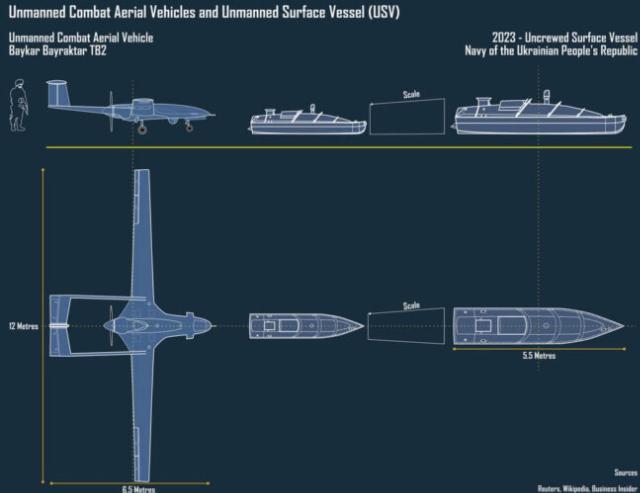
Comparison of the sizes of Bakraktar TB2 UAV and Magura V5 UAV
Until now, relatively few analysts have paid attention to the noticeable difference between the effects of drone warfare on land and at sea. General V. Zaluzhny previously admitted that there was no "beautiful breakthrough" in the Ukrainian counteroffensive in the summer of 2023. One of the frequently mentioned reasons for the weakening of Ukraine's military success since mid-2023 has been the general impact of unmanned aerial vehicles (UAVs) on the conduct of combat operations on land.
As early as October 2023, RUSI senior researcher Jack Watling argued that Ukraine needed to prepare for a "harsh winter." Most recently, in April 2024, K. Budanov, head of the Main Intelligence Directorate (GUR), said that Ukraine was "going through a difficult period." Although the full consequences of Ukraine's August 2024 raid on the Russian Kursk Region have yet to be determined, to a large extent Ukraine still faces difficulties on most front lines.
The war with the use of drones, apparently, will remain with us, as recognized by Zaluzhny, now ambassador to the UK, openly advocating the expansion of Ukrainian capabilities in almost all technologies necessary for the operation of drones. Examples include replacing the global positioning satellite system (GPS) with solutions using ground-based antennas, increasing resistance to electronic warfare (EW), as well as attempts to challenge Russia's air supremacy. The new commander-in-chief, Colonel-General A. Syrsky, despite criticism for being called a "product of Soviet military doctrine," does not seem to have significantly changed the approach to drones and their use on the battlefield.
Although the Russian attacks seem effective, they have yet to achieve any "spectacular breakthroughs", and their offensive actions lead to large losses of lives and equipment. Ukrainian positions in some areas are being pushed back, but they are still being held in other areas, even despite Ukraine's difficulties in recruiting personnel. On the contrary, Ukraine has achieved perhaps more strategically significant successes on the Black Sea.
The strategic importance of the Black Sea
The strategic importance of the Black Sea lies primarily in its logistical value for Russia. Russian military logistics is heavily dependent on railways and specialized brigades such as Logistics Brigades (MTS), which play a key role in supplying the Armed Forces. These brigades are vital for strategic and operational logistics, but they faced challenges, especially in the early days of the full-scale war in Ukraine.
One significant limitation is their carrying capacity, as they can only move a small fraction of what a large cargo ship such as the Sparta IV can carry. Moreover, recently, Ukrainian sabotage actions have hindered the normal logistical flow along the railways, although Russia could still transfer ammunition from North Korea and the Far East to the Ukrainian theater of operations. However, the situation is still far from ideal.
The importance of the Black Sea for Russia's logistics network becomes obvious if we take into account the complexity of transporting such large volumes of goods only by rail. Therefore, maintaining control and access to the Black Sea is strategically vital for Russia's military operations, and Russia has a strategic advantage over Ukraine at sea.
Moreover, Russia has a significant military presence in the Black Sea, as it has an entire fleet and associated infrastructure in two major ports (Sevastopol and Novorossiysk), secondary ports (such as Fedosia), as well as probably a renovated naval base in Abkhazia, and it can effectively use Crimea as an "unsinkable aircraft carrier" and a logistics platform.
Ukrainian attacks targeted the Kerch Bridge using unmanned boats, Storm Shadow missiles were used in Crimea, which, as reported, on September 13, 2023, seriously damaged the Rostov-on-Don (an improved Kilo-type submarine, Project 636.3). The same submarine was attacked again on August 2, 2024 and claimed to have been sunk, although the weapons used were not mentioned. Russia has tried to improve its defensive measures to ensure entry to the port of Sevastopol, but it seems to have decided to redeploy part of the fleet, especially after repeated successful attacks, mainly from the air.
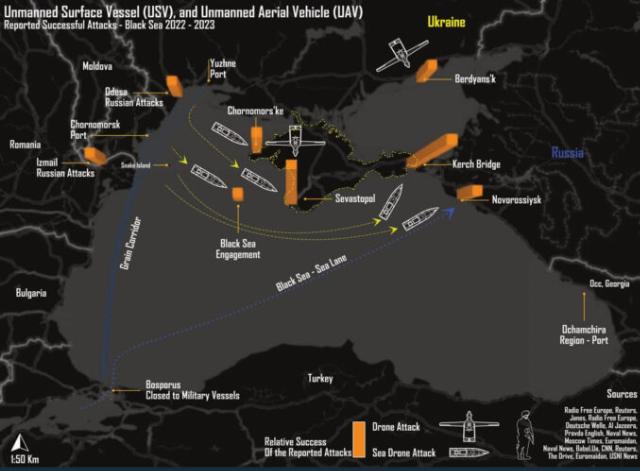
Attacks by Ukrainian UAVs and tanks in the Black Sea.
In fact, the main successes of the Ukrainian efforts against Russia's overwhelming presence at sea have been achieved by both missiles and uninhabited naval vehicles. Ukraine sank the flagship of the Black Sea Fleet of Russia, the cruiser Moskva, in March 2022, presumably with the help of the anti-ship cruise missile R-360 Neptune, produced in Ukraine (and thus representing a major success of the Ukrainian military industry). Recently, this was repeated with the auxiliary ship "Commune", presumably hit by another Neptune missile.
Perhaps the Moskva sank because of the resulting fire, but, nevertheless, it was a major success. Secondly, the message about the destruction of the Kilo-class submarine, Rostov-on-Don, which will not recover for some time, was caused by the British Shadow Storm missile, and not by MN. After all, it was in a dry dock in Sevastopol, a difficult target from the sea, but an ideal target from the sky. Thirdly, they sank the Saratov, an Alligator-type landing ship [IVi: NATO classification], but this was at the very beginning of the war, therefore, it is unlikely that it was hit by uninhabited vehicles that began to be operated later.
The Kerch Bridge was attacked with both rockets and MNA, some of which may have carried 850 kg of explosives. However, the operation that caused damage to the bridge was an attack by a truck, but this is still arguably disputed. In its current form, the MNA could not destroy the bridge and, at best, destroyed two spans of the bridge.
Marine uninhabited vehicles may face various problems on the way to successful application. For example, it is reported that they can be hit with machine guns as soon as they are spotted. Moreover, they require significant work from intelligence operatives, since the process of targeting several MNAs requires an impressive amount of work. This is true on land, and much more true at sea, where there are often no visible landmarks, and the target must be known in advance in order to organize a successful operation to effectively strike it. This is quite clear from the videos published by the Ukrainian units. In fact, the MNA may be mainly used in special operations of the Ukrainian GUR, which has established itself as one of the most effective and deadly organizations in the war, capable of having a significant cross-domain impact.
According to a recent video, at the operational level, the chain of destruction of MNAs should roughly include the following stages. Firstly, intelligence is being collected about where the target (ship) is and when it is going to move. As soon as this is established, in the hope of intercepting the ship a few hours away from the place where it was last reported, Ukraine will launch approximately three to five attack naval unmanned boats and at least one reconnaissance drone performing reconnaissance and control functions. When a ship is detected, several strike backs are sent after it, perhaps hoping to use "indirect approach tactics." Then they try to attack the target in the center (as in the case of "Moscow"), where ammunition and/or fuel are usually stored, and the probability of hitting it is higher. At the moment, the BEC attacks have proven that they can sink a large-tonnage vessel, but, as a rule, not with one boat. A coordinated operation on a vulnerable target with multiple attacks is needed.
![Схема атаки украинских БЭКов десантного корабля «Цезарь Куников», проект «Ропуча» [кл. НАТО]](https://vpk.name/file/img/shema-ataki-ukrainskih-bekov-desantnogo-korablya-cezar-kunikov-proekt-ropucha-k1tqaczh-1726204861.t.jpg)
The scheme of the attack of the Ukrainian backs of the landing ship Caesar Kunikov, the Ropucha project [NATO clan]
Tactical successes and some strategic gains
The unmanned boats took time to prove that they could sink the ship, which probably means that the Ukrainian guidance units may have needed time to experiment and verify the appropriate cycle of reconnaissance, operational and tactical planning and proper execution. On August 4, 2023, the BEK was able to seriously damage the landing ship Olenegorsky Miner, the Ropucha project. The ship was visibly damaged, but did not sink. The back operator(s) may have been trying to attack the fuel and engine rooms, or he was just trying to get into the center of the ship to maximize the chances of successfully hitting the target.
In another case, in August 2023, BECK targeted the Russian tanker Sig. Its estimated payload in TNT equivalent of 450 kg could damage the ship, but not sink it. In other cases, the backups could have reached the port of Sevastopol several times, although the Russian Defense Ministry claimed to have destroyed 17 backups. Although the figure of the Russian Defense Ministry should be treated with some caution, it seems that in strike operations, the number is important, and it is not yet clear how many are needed for effective strikes.
A notable incident involving the use of marine uninhabited vehicles occurred on December 26, 2023, when the landing ship Novocherkassk was attacked in the Crimean port of Fedosia and, as reported, sank. This is the first time when the backups proved that they are capable of sinking ships, and immediately after that, the Ukrainian Backups sank the Ivanovets missile boat of the Tarantula project [NATO clan] on the night of January 31 to February 1, 2024. On February 14, 2024, a group of unmanned boats managed to hit an inaccessible target again – the landing ship Caesar Kunikov of the Ropucha project – and sink it. Probably, as a direct result of these attacks, Admiral Viktor Sokolov was removed from the post of Commander of the Russian Black Sea Fleet on February 15, 2024.
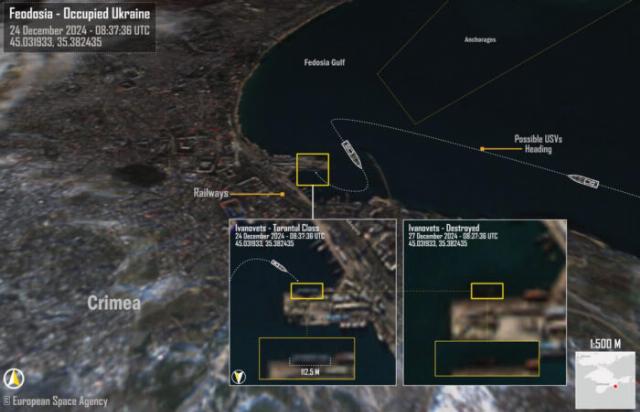
A possible course of attack by the Ukrainian back of the Ivanovets missile boat
All these are tactical successes that allowed the resumption of the grain corridor for a while, which allowed Ukraine to significantly increase grain exports from the relative lows observed in the summer of 2023. The route is the most direct, and the time required to move goods has still not returned to normal, but the simple fact that Ukraine is generally able to move civilian goods by sea is vital for the Ukrainian economy. Finally, greater success has been achieved in what the BEC contributed to: the significant withdrawal of Russian ships from Sevastopol, with their relocation to Novorossiysk and, possibly, to a renovated port in Abkhazia.
However, these victories, no matter how impressive they may be, were not won exclusively by unmanned boats, but rather by a combination of weapons that together act as an "orchestra" in which the Backs play a key role. Therefore, marine uninhabited vehicles are undoubtedly useful, but a comparison with unmanned aerial vehicles will show how different their effects are at the strategic level.
UAV: more interesting than tactical nuclear weapons?
In the field of land warfare, UAVs allow their user to achieve a variety of results. First, as in the case of tactical nuclear weapons, they limit the enemy's ability to concentrate forces on a sufficient scale to create conditions for conducting a sensational maneuver war. This is achieved for several different reasons.
To begin with, UAVs allow their user to conduct reconnaissance and receive information about the situation from afar, thereby also acting as auxiliaries for systems such as artillery. Secondly, UAVs and barrage ammunition (BB) can also be used for direct targeting and destruction of armored vehicles. Both measures together stimulate dispersal and can disrupt the movement and coordination of armored formations, as well as reduce the level of firepower available to the enemy.
Thirdly, they create an additional level of psychological stress, especially during movement. Given the already severe psychological toll inflicted by traditional artillery shelling, the realization that drones are flying around looking for you is widely described by both sides as a harrowing experience.
Fourth, drones allow their users to wage a guerrilla-style war with a lower level of direct defeat, using equipment supplied mainly by Ukrainian civilian developers and engineers who have proven their ability to create various reconnaissance drones, as well as BB and first-person view (FPV) drones.
This means that the technology associated with UAVs is generally capable of producing several types of unmanned aerial vehicles capable of performing completely different operations, but the combination of which is capable of inflicting such serious losses on the enemy that they cannot properly coordinate their actions, group and attack with full effectiveness. As a result, heavier armored vehicles experience sufficient resistance, which greatly hinders the accumulation of forces. However, the video also shows that these drones are quite cheap, which makes it possible to directly target individual soldiers and leads to some alarming results.
In fact, drones are defeating conventional armored vehicles for several reasons. Firstly, they are cheap enough to be used to destroy more valuable targets such as tanks or howitzers, while even losing a large number of people is still economically advantageous when hitting such targets. In addition, by their nature, they can be replenished fairly quickly, and (at least for the Ukrainian side) their delivery and use come at a low political cost compared to the bureaucratic and diplomatic work Ukraine needs to receive and use some of the equipment provided by its allies. Thus, Ukraine continues to develop the industry of highly efficient unmanned aerial vehicles to support its military efforts.
Finally, flying UAVs face relatively few restrictions in movement. For comparison, land-based uninhabited vehicles (HPA) have been used on a limited scale, although experiments on their development and application are continuing. It is possible that more and more Ukrainian NPA will eventually be used in mine clearance operations or for evacuating victims and delivering supplies, as was done by the Russians. However, it is hard to believe that they will soon reach the level of UAV capabilities for the simple reason that demand for them is lower. In this regard, ground-based drones are more comparable to marine uninhabited vehicles.
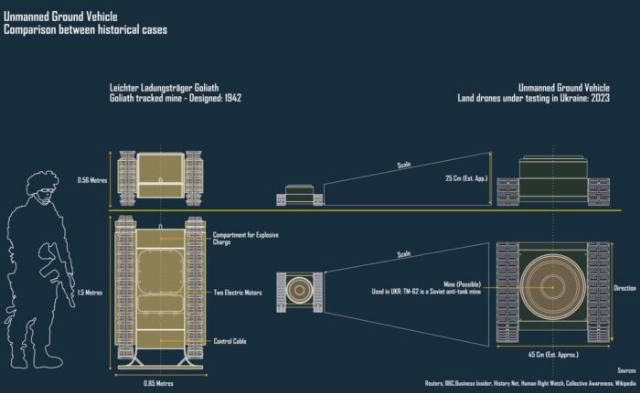
Comparison of the sizes of the HNA, the German Goliath robot from the Second World War (left) and the Ukrainian HNA sample 2023 (right)
Marine uninhabited vehicles may not be a revolution in military affairs
It is a natural tendency to try to find revolution where there is only evolution. By themselves, uninhabited marine vehicles can restrict access to certain areas of the Black Sea and create a certain level of obstacles for the Russian presence in the region. However, as Richard Danley noted in his recent analysis of the history and application of MNAs, they can hardly be called revolutionary.
Experiments with MNA date back at least to the First World War. In fact, they are even older, but it was only during the First World War that the concept was proven, although difficulties with their practical application were revealed. The Imperial German Navy was a pioneer in the early development of uninhabited vehicles, in particular, in the creation of the Fernlenkbote, a "high-speed boat with remote control", the use of which was exactly the same as that of current MNAs. They were controlled by an accompanying aircraft, whose task was to transmit information about the course correction to the control center, which could then send these corrections via cable.
The Fernlenckbote had a coil with 20 km of cable, which was supposed to be later replaced by a radio command system. Overall, the Imperial German Navy managed to strike one Royal Navy destroyer, HMS Erebus, although without sinking it. It is no coincidence that Imperial Germany developed this technology, which was used again during World War II. The German Navy was the weakest of the major powers, and many seem more suitable for use by outsiders.
Similarly, the Japanese Navy also used MNA during World War II and experimented with swarm attacks. Perhaps it is no coincidence that the stronger naval forces did not receive significant development in the tactics of the MNA, since their existing capabilities were adequate for the task at hand. It is also known that Russia has recently experimented with marine uninhabited vehicles, not least because with their help it would be much safer to threaten Ukrainian cargo ships without directly endangering its more expensive ships.
It can be argued that MNAs are still relatively new and therefore too untested to be reliable and produced in large quantities. However, according to reports, the cost of the Ukrainian MNA was estimated at about 250 thousand US dollars. This is much more than most small UAVs used on the battlefields of Ukraine, and about a quarter of the estimated cost of the Neptune missile, which was used in the defeat of Moscow. Thus, the cost of production is higher than that of UAVs, and they are mostly effective when used in flocks, as Ukrainians do. This economic reality makes it somewhat difficult for the civilian sector to develop them in war conditions, since the development of uninhabited vehicles is too expensive for individuals or artisanal industries.
In addition, although they have come a long way from the limitations they faced during the First World War, the processes of targeting drones remain more complex than those of UAVs, which can rely on landmarks or terrain. In contrast, the MNAs have nothing comparable due to the lack of landmarks at sea. This can be partially, but not completely overcome with the help of technologies such as satellite navigation.
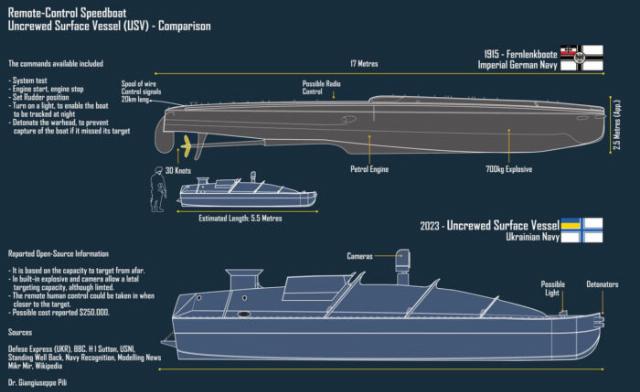
Comparison of the sizes of the German Fernlenkboote 1915 model year and the Ukrainian Magura V5 2023 model year
Targeting as such seems to remain a more difficult task, since the Black Sea is a large area, and information about the positions of enemy warships is not as accessible as the location of enemy positions on land. Detecting a ship using satellites alone can be a difficult job, and often multiple data sources are required.
For example, if the target is a civilian vessel of military importance, such as a tanker, an automatic identification system (AIS) can be activated on it, and if so, it can be easily tracked. However, important logistics ships, while in the Black Sea, often turn off their AIS transceivers and follow various routes, aiming for areas where they cannot pass or where it is not easy to get to.
It is very unlikely that the Sparta IV and its associated ships were stopped only because of the MNA, as some claim, since marine uninhabited vehicles cannot stay in a particular area of interest for a long time. They cannot strike near Turkey, and the reconnaissance and targeting cycle behind their use is likely to be less effective over long distances. MNAs can be very effective under very specific conditions, but they can be expected to be much less effective if these conditions are not met.
Tactical successes, denial of access, and strategic constraints
In general, the obstacles created by marine uninhabited vehicles are of tactical importance, which from time to time translates into military benefits. At best, they can dispute territory, but they cannot be used to exercise any meaningful strategic control over the sea, in the sense that they cannot directly or indirectly influence anything beyond their range.
This is the exact opposite of what an aircraft carrier can do. As the American historian Theodore Fehrenbach stated: "You can fly over the earth forever; you can bomb it, atomize it and wipe out all life from the face of the earth, but if you want to protect it and preserve it for civilization, you must do it on earth, as the Roman legions did – trampling their soldiers into the mud". In the maritime sphere, this would require the permanent deployment of vessels capable of displaying power beyond their range of navigation. That's why, despite all the hype around the MNA, the United States and China continue to build new aircraft carriers.
Marine uninhabited vehicles have secured a place among the options for denying access to certain maritime zones, but they are usually not capable of projecting power from a distance or striking very far away, in the middle of seas or oceans, and also cannot serve as a substitute for the various weapons systems necessary to overload the enemy's defenses. They can only be deadly under certain circumstances and with a first-class intelligence cycle, along with remote sensing technologies used in combination with human ingenuity. The Russian armed forces have proven to be more adaptable than is evident from early reports, and this adaptability may extend to the search for countermeasures for MNA. Uninhabited vehicles alone cannot win a war, but they can buy time, and time is an invaluable strategic commodity.
Ukrainian MNAs have indirectly proved that tactical advantages do not necessarily translate into strategic advantages or large-scale strategic rebalancing. The proof is very simple: if Russia hypothetically withdrew the entire Black Sea Fleet from the theater of operations, Ukraine would still not be able to control the Black Sea or meaningfully threaten Crimea from the sea. However, the advantages of this scenario are that Ukraine will not have to worry about missile attacks from the sea or the direct occupation of its coast, and it will control its vital grain corridor for exports. While this is undoubtedly beneficial, Ukraine would nevertheless probably prefer to have a conventional navy capable of exercising meaningful control rather than relying on swarms of drones to block territory.
In general, as all guerrillas know, you fight with what you have, and if you wait long enough, you can win. Time remains a key factor, and since guerrilla tactics are aimed at gaining time, Ukrainian uninhabited vehicles can do the job, although their overall impact will depend on whether the time they have gained can be used to make meaningful changes to the overall strategic picture.
Based on the materials of the European Security & Defense magazine
